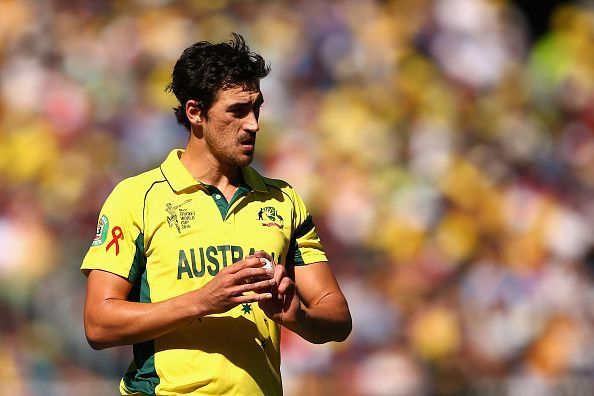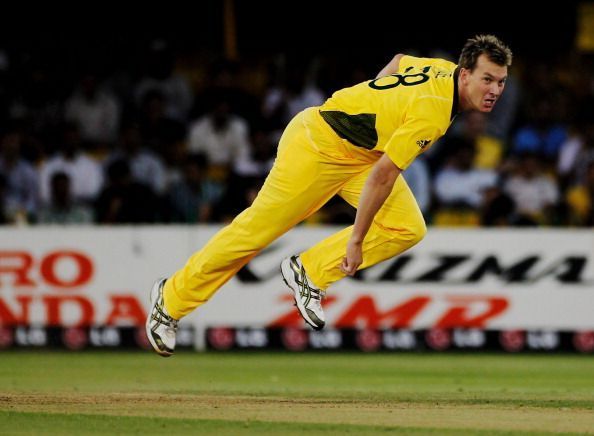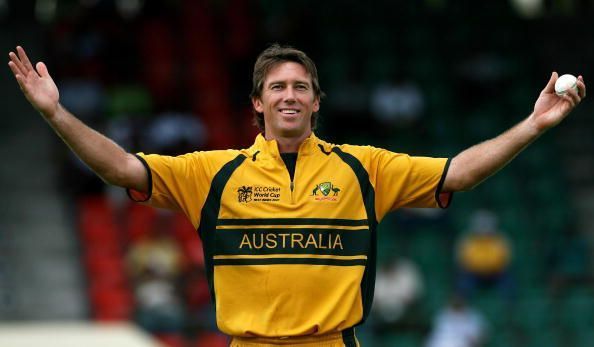
Australia has always had excellent cricketers in all areas of the game. One thing Australia is especially known for is its strong fast bowling. In Tests, ODIs, or T20Is, Australian fast bowlers have always been tough for even the best batsmen to face. Many great fast bowlers have come from Australia, with some becoming the best in the world.
Let’s look at the Top 10 Australian fast bowlers of all time.
10. Ray Lindwall

Ray Lindwall was one of the best fast bowlers in the 1950s. He used to play rugby and was famous for his speed and swing. Lindwall took 228 wickets in 61 Test matches, with 12 five-wicket hauls. His best bowling in a Test match was 7/38 against India in Adelaide in 1948.
Lindwall was a key player in the Australian team of 1948, known as The Invincibles. He and Keith Miller made a tough fast-bowling pair that many batsmen found hard to face. Lindwall’s best time came in England in 1953.
In a game against Surrey at the Oval, Lindwall bowled an over to Peter May, one of the best batsmen of the post-war period. Lindwall bowled three inswingers and three outswingers in one over, which May considered the best over he had ever faced.
Lindwall had a great Ashes series that year, taking 26 wickets at an average of 18.84. He was also a useful lower middle-order batsman and scored two Test centuries.
ALSO READ: Here are five West Indies players to watch in the ICC T20 World Cup 2024
9. Jason Gillespie

Jason Gillespie became a key player for Australia’s cricket team during a time when their bowling lineup was very strong. Even with great bowlers like Warne, McGrath, and Lee, Gillespie took 259 Test wickets, making him the 6th highest wicket-taker for Australia. He also took 142 wickets in One Day Internationals (ODIs).
Gillespie, a tall and lean fast bowler, started playing for Australia in 1996. By 1997, he secured his place in the Test team with two five-wicket hauls, including his best performance against England at Headingley.
In ODIs, Gillespie achieved three five-wicket hauls, with his best figures being 5/22 against Pakistan in 2002. He was part of the Australian team that won the 2003 World Cup, but he had to leave after four games due to injury.
Gillespie was also a useful lower-order batsman. He famously scored a double-century against Bangladesh in 2006 as a nightwatchman. Despite frequent injuries, he managed to take 400 international wickets before retiring in 2006.
It’s fascinating to think about how much more he could have achieved if injuries hadn’t affected his career.
8. Mitchell Starc

Mitchell Starc is one of the best fast bowlers in the world right now and has been Australia’s main bowler for the past few years. He started playing for Australia in 2010 and has since become a regular player in all formats of the game.
Starc has taken 244 wickets in Test matches, 178 wickets in One Day Internationals (ODIs), and 43 wickets in Twenty20 Internationals (T20Is). He has achieved 20 five-wicket hauls in international cricket, with 13 in Tests and 7 in ODIs. Starc is the fastest bowler to reach 100 ODI wickets, achieving this in just 52 innings.
He is known for his incredible speed and accuracy, and he has also performed well in T20Is.
One of Starc’s best moments with the Australian team was during the 2015 World Cup, where he was named the Man of the Tournament and was the joint highest wicket-taker with 22 wickets, with an economy rate of just 3.58. Additionally, he is a useful lower-order batsman with over 1000 Test runs, including ten fifties.
7. Craig McDermott

Craig McDermott was one of the best Australian bowlers ever and was highly feared by batsmen in the late 1980s and early 1990s. He started playing Test cricket for Australia in 1984 and quickly became a key player.
Known for his fast bowling and outswing, McDermott took 291 Test wickets, which included 14 instances where he took five wickets in a single innings and two instances where he took ten wickets in a match. His best performance in a Test match was taking 8 wickets for 97 runs against England in Perth in 1991. Many of his best performances were against England, where he took 8 out of his 14 five-wicket hauls.
In One Day Internationals (ODIs), McDermott took 203 wickets at an average of 24.71. He played an important role in Australia’s 1987 World Cup win, being the top wicket-taker in the tournament with 18 wickets. This included his only five-wicket haul in ODIs, where he took 5 wickets for 44 runs against Pakistan in the semi-finals.
Unfortunately, McDermott’s career was shortened by injuries in the mid-1990s. These injuries led to his retirement after the 1996 World Cup, when he was only 30 years old.
6. Mitchell Johnson

Mitchell Johnson was one of the best fast bowlers in the late 2000s and early 2010s. Batsmen were always careful when facing him. He started playing for Australia in 2005 and quickly became a key player.
In 2010, Johnson became the fastest to take 150 Test wickets in terms of time (2 years and 139 days). He is Australia’s 4th highest Test wicket-taker with 313 wickets, including 12 five-wicket hauls. His best Test bowling figures are 8/61 against South Africa.
In ODIs, Johnson took 239 wickets, including three five-wicket hauls. His best ODI figures are 6/31 against Sri Lanka.
He was part of Australia’s squad for the 2007 World Cup but didn’t play any matches. In the 2011 World Cup, he took ten wickets as Australia reached the quarter-finals. In the 2015 World Cup, Johnson helped Australia win by taking 15 wickets at an average of 21.73.
Johnson was also part of Australia’s Champions Trophy-winning teams in 2006 and 2009, taking five wickets in 2006 and four in 2009.
In T20Is, Johnson took 38 wickets. He helped Australia reach the final of the 2010 ICC World T20, where he had his best T20 figures of 3/15 against Sri Lanka.
Johnson was also a good batsman, scoring over 2000 runs in Tests, including one century. He also had two fifties in ODIs. He was named the ICC Player of the Year twice, in 2009 and 2014.
5. Charlie Turner

Charlie Turner is seen as one of the best fast bowlers ever and the top fast bowler of the 19th century. He was known for his long run-ups, changing his speed, and being very accurate.
From 1887 to 1895, Turner played in 17 Tests and took 101 wickets, with an amazing average of 16.53. He had 11 five-wicket hauls and two ten-wicket hauls, with his best being 7/43. He was the first player to take 100 wickets in international cricket.
Turner was called “Terror Turner” because he bowled very well even on difficult pitches. His bowling figures of 12/87 against England in Sydney in 1887 are still the best match bowling figures at the SCG.
ASLO READ: The top five Indian batsmen who scored the most runs in a single edition of the T20 World Cup
4. Jeff Thomson

Jeff Thomson, one of the scariest bowlers in cricket history, didn’t start his Test career well. He debuted against Pakistan in 1972 but didn’t take any wickets, ending with 0/110. It’s said he played with a broken bone in his foot.
Thomson didn’t play first-class cricket for almost two years but returned to the national team in the 1974-75 season. During the Ashes series, he had some amazing performances, including taking 6 wickets for 46 runs in one game. This series made him famous, and he became a regular player for Australia.
Known for his incredible speed, Thomson is considered one of the fastest bowlers ever. Along with another fast bowler mentioned later in the article, Thomson formed one of the most dangerous bowling pairs in international cricket.
Thomson was most successful in Test cricket, taking 200 wickets. In One Day Internationals (ODIs), he took 55 wickets. He played for Australia in the 1975 and 1983 World Cups, taking a total of seven wickets.
3. Brett Lee

Brett Lee is one of Australia’s fastest and most dangerous bowlers.
He started his career in 1999 and quickly became important for Australia, regularly bowling at speeds of 150 km/h. Lee had several injuries because of his high-speed bowling, which forced him to change his approach, but he remained very difficult for batsmen to face.
In his nearly 13-year international career, Lee took 310 Test wickets, including ten five-wicket hauls, with his best figures being 5/30. In ODIs, he is Australia’s second-highest wicket-taker with 380 wickets, including nine five-wicket hauls, and his best figures were 5/22. He was a key player in Australia’s 2003 World Cup win, being their top wicket-taker with 22 wickets and taking a hat-trick against Kenya in the Super Sixes. This made him the first Australian and only the fourth bowler to take a hat-trick in the World Cup.
In T20Is, Lee took 28 wickets. He was the first bowler to take a hat-trick in T20Is, achieving this against Bangladesh in the 2007 ICC World T20. Lee’s fastest official delivery was recorded at 161.1 km/h against New Zealand in 2005.
2. Dennis Lillee

Dennis Lillee is considered one of the best fast bowlers in cricket history, but his international career had a rough start due to back problems that almost ended it. However, his determination helped him recover, and he became one of the most feared bowlers in the 1970s and early 1980s.
Lillee and Jeff Thomson formed a legendary fast-bowling pair in the 70s. Lillee troubled even the best batsmen. In 1981, he became Australia’s top wicket-taker in Tests, surpassing Richie Benaud. He also broke Lance Gibbs’ record for the most Test wickets, achieving this milestone against the West Indies.
Lillee also had a strong partnership with wicket-keeper Rod Marsh, with the duo making 95 dismissals in 69 Tests, a record that still stands. Lillee took 355 Test wickets, including 23 five-wicket hauls, with his best figures being 7/23.
In One Day Internationals (ODIs), Lillee wasn’t as dominant but still took 103 wickets, including a five-wicket haul of 5/34 against Pakistan in the 1975 World Cup.
1. Glenn McGrath

You’ve probably guessed by now who takes the top spot here: Glenn McGrath. Widely considered the greatest fast bowler ever, McGrath was a key player in Australia’s dominance from the mid-90s to the mid-2000s.
While McGrath wasn’t the fastest bowler, his precise line and length made him very effective at taking wickets. He holds the record for the most Test wickets by a fast bowler, with 563, including 29 five-wicket hauls and three ten-wicket hauls. He’s also one of the few bowlers to take two 8-wicket hauls in Test cricket, with his best figures being 8/24 against Pakistan.
In ODIs, McGrath is Australia’s top wicket-taker with 381 wickets, including seven five-wicket hauls. His best performance was 7/15 against Namibia in the 2003 World Cup. He played a major role in Australia’s three World Cup wins from 1999 to 2007.
In the 1999 World Cup, he was the second-highest wicket-taker with 18 wickets. In 2003, he was third with 21 wickets. He took 26 wickets in 2007, the most in any single World Cup tournament, and was named Player of the Tournament. McGrath is also the leading wicket-taker in World Cup history with 71 wickets.
Clearly, he is Australia’s greatest fast bowler ever.
READ MORE:












